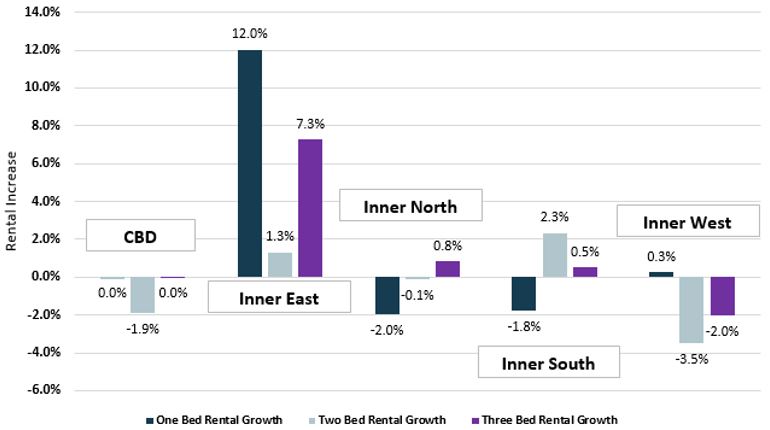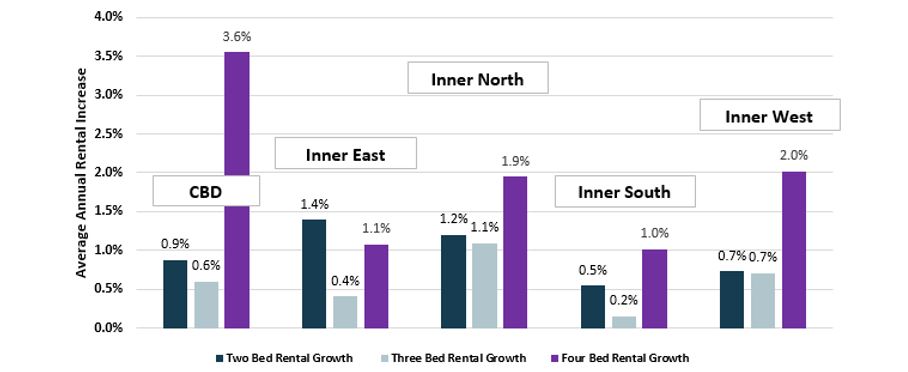Following our most recent report which covered new apartment performance, Place Advisory now takes a look at how the Inner Brisbane rental market has weathered the influx of new apartments over recent years.
Brisbane Vacancy Rate
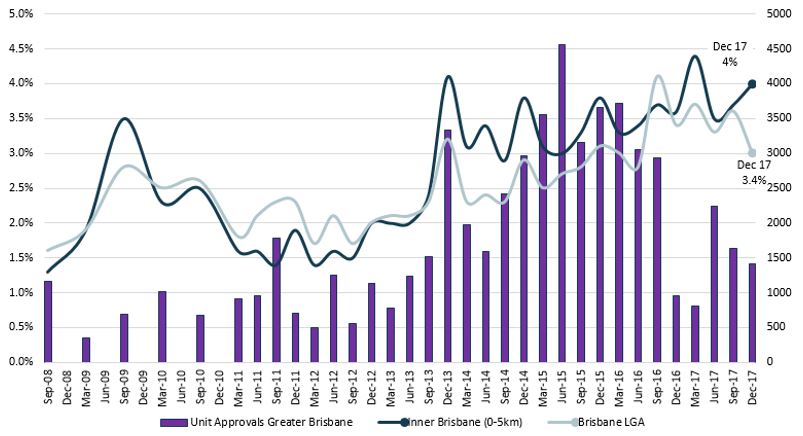
Source: Real Estate Institute Queensland, Australian Bureau of Statistics. Prepared by Place Advisory
As can be seen in the graph above, Inner Brisbane’s vacancy rate has consistently been in the range of 3% to 4% since mid-2013, in line with high levels of apartment development in the area. However, before this, the Inner Brisbane rental market was noticeably tighter, in the range of 1.5% to 2.5% vacancy. At the end of 2017, the Inner Brisbane area had a vacancy rate of 4% whilst, the Greater Brisbane vacancy rate appears to be beginning a downward trend.
Following is a breakdown of rental performance for both houses and apartments over the past 12 months ending March 2018 in Inner Brisbane. Read on to find out what is happening in your precinct.
Inner Brisbane Apartment Rental Performance 12 Months to March 2018
Source: Residential Tenancies Authority. Prepared by Place Advisory.
Inner Brisbane House Rental Performance 12 Months to March 2018
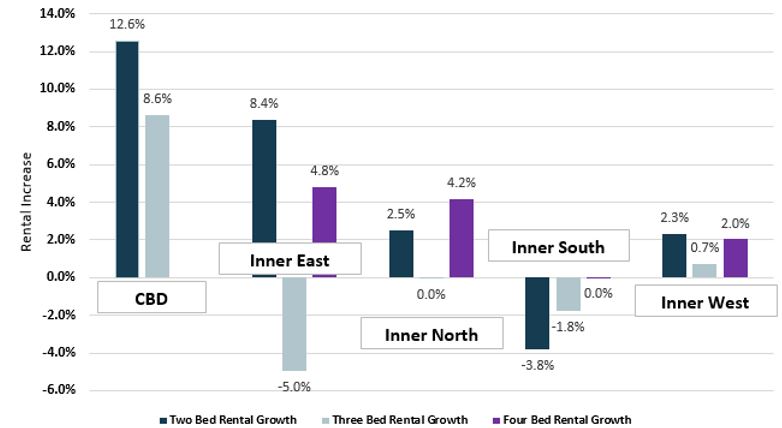
Source: Residential Tenancies Authority. Prepared by Place Advisory.
CBD
Over the last 12 months ending March 2018, the CBD precinct, which includes Brisbane City and Spring Hill, has been a two speed market. Apartments here have recorded no growth in rents with two bedroom apartment rent declining by 1.9% during the period. One and three bedroom apartment rents remained steady with 0% growth. In contrast, the area’s small housing market has seen rents for two and three bedroom houses increase by an impressive 12.6% and 8.6% respectively.

Source: Residential Tenancies Authority. Prepared by Place Advisory.
Inner North
Brisbane’s Inner North precinct has been a middle performer compared to the other precincts. Apartment rent has seen minimal changes in the past 12 months whilst, houses have seen steady growth. One and two bedroom apartments in the precinct recorded rental growth of -2% and -0.1% respectively, whilst three bedroom apartment rent increased by 0.8%. Houses on the other hand, recorded growth in two and four bedroom configurations at a rate of 2.5% and 4.2% respectively. Three bedroom house rent remained steady during the period. The precincts standout performers were three and four bedroom houses in the postcode areas of 4005 and 4007 respectively.

Source: Residential Tenancies Authority. Prepared by Place Advisory.
Inner East
Brisbane’s inner eastern suburbs have been strong performers, recording easily the best overall rental growth for apartments and second best for houses. Rent for one bedroom apartments in the precinct increased by 12% over the 12 months to March 2018 – Easily the best performing apartments in Inner Brisbane! Three bedroom apartments followed with an impressive 7.3% while two bedroom apartments recorded 1.3% growth during the same period. Two and three bedroom houses similarly performed well, recording rental growth of 8.4% and 4.8% respectively. The only negative for the precinct was a 5% decline in rent for three bedroom houses. This precinct was weighed down by the poor performance of houses in the postcode area of 4171 which consists of Balmoral, Bulimba and Hawthorne.

Source: Residential Tenancies Authority. Prepared by Place Advisory.
Inner Brisbane Rental Performance: 12 Months Ending March 2018
Source: Residential Tenancies Authority. Prepared by Place Advisory.
This map is interactive. Click around on your postcode to get further information rental performance information.
Inner South
Similar to the other Inner Brisbane precincts, with the exception of the Inner East, rental growth in Brisbane’s inner south has been a mixed bag for apartments. Houses here have also performed the worst of all five precincts in Inner Brisbane. One bedroom apartment rent declined slightly by 1.8% in the precinct whereas two and three bedroom apartment rent increased by 2.3% and 0.5% respectively. Houses on the other hand, saw no rental growth and declines of 3.5% and 1.8% in two and three bedroom configurations. Houses in the postcode area of 4101 were the main catalyst for poor rental performance in the precinct.

Source: Residential Tenancies Authority. Prepared by Place Advisory.
Inner West
Brisbane’s Inner West precinct found apartment rental growth difficult to come by over the last 12 months, whereas, the precincts housing market was much steadier, recording growth in all house configurations. One bedroom apartments were the only configuration to record rental growth during the period at 0.3%. Two and three bedroom apartments recorded rental declines of 3.5% and 2% respectively. In contrast, two, three and four bedroom houses saw rental growth of 2.3%, 0.7% and 2% during the past 12 months ending March 2018 respectively. Whilst there were no standout performers for apartments, one bedroom houses in the postcode area of 4066 and three bedroom houses in 4059 recorded impressive rental growth during the period.

Source: Residential Tenancies Authority. Prepared by Place Advisory.
While, the Inner Brisbane rental market appears to be navigating a difficult period of the property cycle, it is clear that not all areas and property types are being affected negatively.
Inner Brisbane Apartment Annual Rental Growth Rates: 5 Years to March 2018
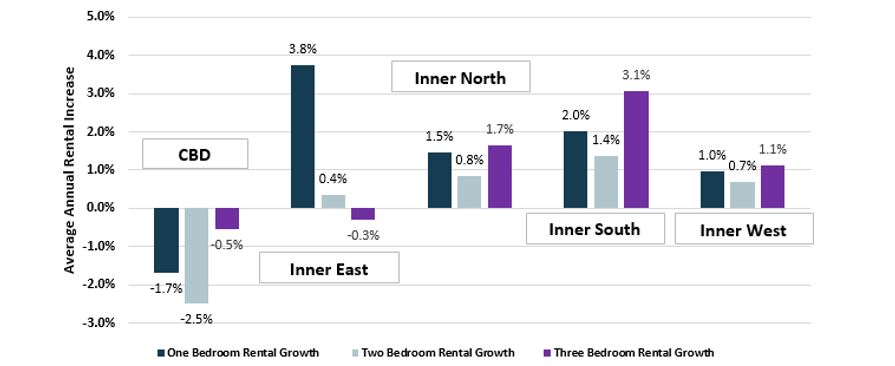
Source: Residential Tenancies Authority. Prepared by Place Advisory
Whilst, the Inner Brisbane apartment market has seen minimal yet recovering growth over the past 12 months ending March 2018, looking back five years shows that rental growth has been much more consistent. With the exception of the CBD, all precincts have recorded apartment rental growth over recent years.
Source: Residential Tenancies Authority. Prepared by Place Advisory
The Inner Brisbane housing rental market has been a strong performer over the last five years ending March 2018. Rental growth has been recorded over all property types in all precincts. Whilst, not necessarily outperforming the corresponding apartment market, the housing market has produced a more stable performance over recent years.
Conclusion
Whilst, vacancy rates have increased over recent years in Inner Brisbane the data shows that new supply has been largely absorbed at a sustainable rate, avoiding significant vacancy in the market. However, this increased vacancy rate over previous years has resulted in some decline in rental rates throughout Inner Brisbane.
Currently, the Inner Brisbane rental market appears to be stabilising as residential construction begins to wind down with the last significant wave of apartment supply set to enter the marketplace throughout 2018.
Place advisory expects rental vacancy to remain steady in the short term before beginning to decline as new supply is further absorbed and the resident population continues to increase. As vacancy rates decline, stronger signs of rental growth will inevitably be seen throughout the Inner Brisbane apartment market.
